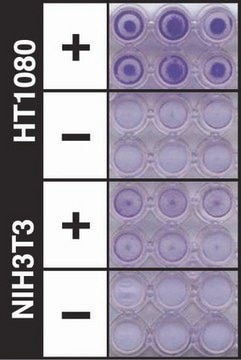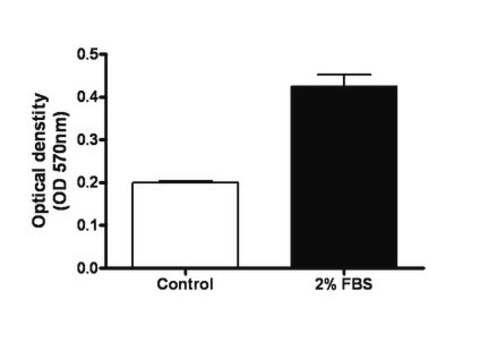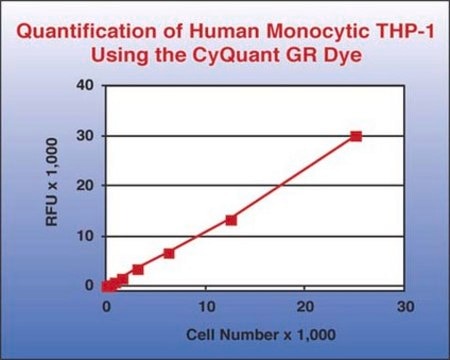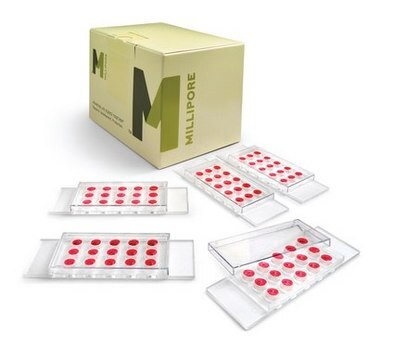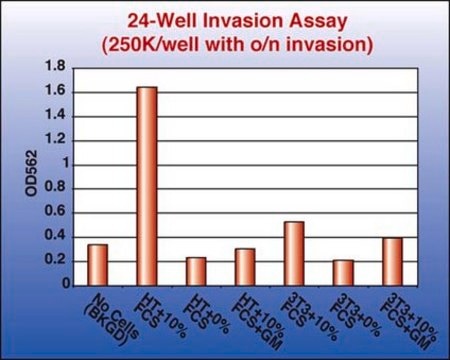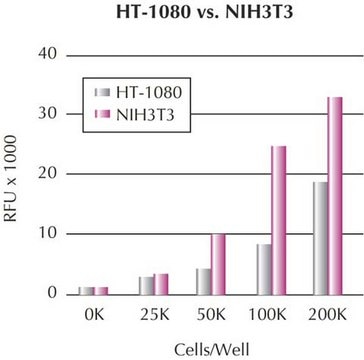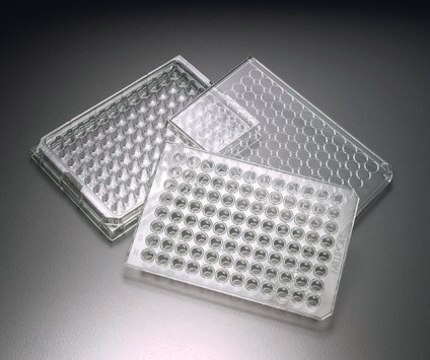ECM508
QCM Chemotaxis Cell Migration Assay, 24-well (8 µm), colorimetric
The QCM 24-well Migration Assay is ideal for the study of chemotaxis cell migration. The assay uses a 24-well plate with an 8 micron pore size, with colorimetric detection.
Synonym(s):
cell migration assay, colorimetric chemotaxis assay
Sign Into View Organizational & Contract Pricing
All Photos(1)
About This Item
UNSPSC Code:
12352207
eCl@ss:
32161000
NACRES:
NA.84
Recommended Products
Quality Level
species reactivity (predicted by homology)
all
manufacturer/tradename
Chemicon®
QCM
technique(s)
activity assay: suitable
cell based assay: suitable
detection method
colorimetric
shipped in
wet ice
Related Categories
Application
Research Category
Cell Structure
Cell Structure
The CHEMICON QCM 24-well Migration Assay is ideal for the study of chemotaxis cell migration. Each Chemicon Cell Migration Assay Kit contains sufficient reagents for the evaluation of 24 samples. The quantitative nature of this assay is especially useful for screening of pharmacological agents.
The CHEMICON QCM 24-well Migration Assay is intended for research use only; not for diagnostic applications.
The CHEMICON QCM 24-well Migration Assay is intended for research use only; not for diagnostic applications.
Packaging
24 wells
Components
Sterile 24-well Cell Migration Plate Assembly: (Part No. 90333) Two 24-well plates with 12 inserts per plate (24 inserts total/kit).
Cell Stain: (Part No. 90144) One 20 mL bottle.
Extraction Buffer: (Part No. 90145) One 20 mL bottle.
Cotton Swabs: (Part No. 10202) 50 each.
Forceps: (Part No. 10203) One each.
Cell Stain: (Part No. 90144) One 20 mL bottle.
Extraction Buffer: (Part No. 90145) One 20 mL bottle.
Cotton Swabs: (Part No. 10202) 50 each.
Forceps: (Part No. 10203) One each.
Storage and Stability
Store kit materials at 2-8°C for up to their expiration date. Do not freeze.
Legal Information
CHEMICON is a registered trademark of Merck KGaA, Darmstadt, Germany
Disclaimer
Unless otherwise stated in our catalog or other company documentation accompanying the product(s), our products are intended for research use only and are not to be used for any other purpose, which includes but is not limited to, unauthorized commercial uses, in vitro diagnostic uses, ex vivo or in vivo therapeutic uses or any type of consumption or application to humans or animals.
signalword
Danger
hcodes
Hazard Classifications
Eye Irrit. 2 - Flam. Liq. 2
Storage Class
3 - Flammable liquids
wgk_germany
WGK 1
flash_point_f
53.6 °F
flash_point_c
12 °C
Certificates of Analysis (COA)
Search for Certificates of Analysis (COA) by entering the products Lot/Batch Number. Lot and Batch Numbers can be found on a product’s label following the words ‘Lot’ or ‘Batch’.
Already Own This Product?
Find documentation for the products that you have recently purchased in the Document Library.
Customers Also Viewed
Su Jin Hwang et al.
Scientific reports, 6, 21596-21596 (2016-02-18)
Brain metastasis is the most common type of intracranial cancer and is the main cause of cancer-associated mortality. Brain metastasis mainly originates from lung cancer. Using a previously established in vitro brain metastatic model, we found that brain metastatic PC14PE6/LvBr4
Tieqiang Zhao et al.
American journal of physiology. Heart and circulatory physiology, 304(12), H1719-H1726 (2013-04-16)
Platelet-derived growth factor (PDGF)-D is a newly recognized member of the PDGF family with its role just now being understood. Our previous study shows that PDGF-D and its receptors (PDGFR-β) are significantly increased in the infarcted heart, where PDGFR-β is
Sonja Suvakov et al.
Biology of sex differences, 10(1), 49-49 (2019-09-16)
Preeclampsia is a pregnancy-specific hypertensive disorder characterized by impaired angiogenesis. We postulate that senescence of mesenchymal stem cells (MSC), multipotent cells with pro-angiogenic activities, is one of the mechanisms by which systemic inflammation exerts inhibitory effects on angiogenesis in preeclampsia.
The L6 domain tetraspanin Tm4sf4 regulates endocrine pancreas differentiation and directed cell migration.
Keith R Anderson,Ruth A Singer,Dina A Balderes,Laura Hernandez-Lagunas et al.
Development null
Presenilin 1/gamma-secretase is associated with cadmium-induced E-cadherin cleavage and COX-2 gene expression in T47D breast cancer cells.
Chang Seok Park,Ohn Soon Kim,Sang-Moon Yun,Sangmee A Jo,Inho Jo,Young Ho Koh
Toxicological Sciences null
Our team of scientists has experience in all areas of research including Life Science, Material Science, Chemical Synthesis, Chromatography, Analytical and many others.
Contact Technical Service